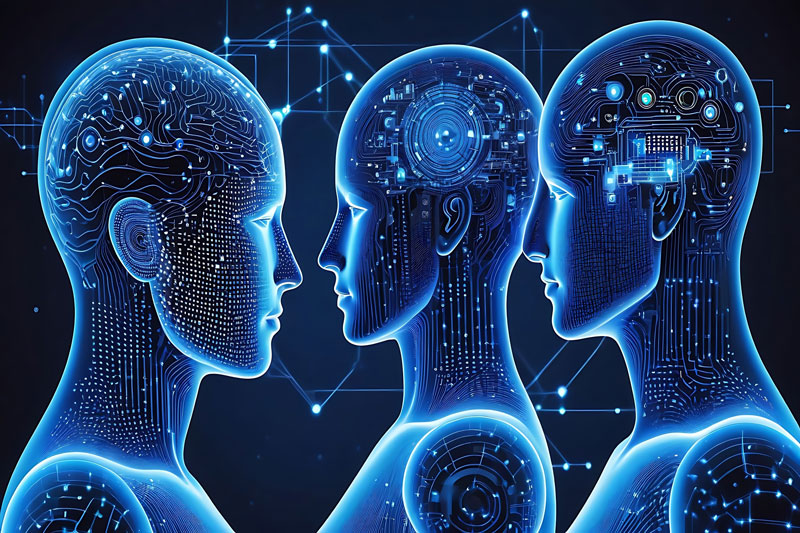Sklearn multilayer Perceptron Learning Algorithm Explained : In the ever-evolving landscape of artificial intelligence and machine learning, there are foundational concepts that serve as cornerstones to the understanding of more complex algorithms and models. Among these fundamental building blocks, the perceptron stands tall as one of the earliest and simplest forms of artificial neural networks. While its structure may seem rudimentary in comparison to today’s advanced deep learning architectures, the perceptron’s significance transcends its simplicity.
The story of the perceptron is a testament to the enduring quest of scientists and researchers to replicate the human brain’s remarkable ability to learn, adapt, and make decisions. Conceived in the late 1950s by Frank Rosenblatt, the perceptron was envisioned as a computational model inspired by the neurons in our brain. It was not only a pioneering moment in the history of artificial intelligence but also a catalyst for further exploration into the realm of neural networks.
At its core, the perceptron represents the essence of binary classification—a task of assigning inputs to one of two possible classes. It encapsulates the essence of a decision-making unit, operating on the principles of weighted sums and activation functions. Understanding the perceptron is akin to opening a gateway into the realm of neural networks, offering insights into concepts like learning, generalization, and the intricate dance between input, weights, and output.
In this article, we embark on a journey of exploration into the perceptron—a journey that takes us from its humble beginnings to its enduring relevance in contemporary machine learning. We will unravel the mathematical intricacies that govern its operation, delve into the historical milestones, and explore its role as a foundational element in the modern neural networks that power applications ranging from natural language processing to computer vision.
As we venture deeper into the world of perceptrons, we will gain a profound appreciation for the simplicity that underlies complexity, and we will uncover how this seemingly elementary concept has paved the way for the sophisticated AI systems of today. So, let us begin our journey of discovery, armed with curiosity and guided by the ever-shining beacon of the perceptron.
Relu Activation Function in Torch & Keras | Code with Explanation
Supervised Learning Types & Methods Explained
Unlocking the Secrets of the Brain: A Dive into Hebbian Learning
you may be interested in the above articles in irabrod.
What is a Perceptron ?
A perceptron is a type of artificial neuron or node in the field of machine learning and artificial intelligence. It is the simplest form of a feedforward neural network, often used for binary classification tasks. The perceptron is named after the mathematical concept of a “perceptron,” which is a simplified model of a biological neuron’s behavior.
Here are the key components and characteristics of a perceptron:
1. Inputs (x): A perceptron takes one or more input values, denoted as x₁, x₂, …, xᵢ. These inputs are numerical values representing various features or attributes of the data to be processed.
2. Weights (w): Each input is associated with a weight, denoted as w₁, w₂, …, wᵢ. Weights represent the strength or importance of each input. They are parameters that the perceptron learns during training.
3. Summation Function: The perceptron calculates the weighted sum of its inputs. This is done by multiplying each input by its corresponding weight and summing up the results:
sum = w₁ * x₁ + w₂ * x₂ + … + wᵢ * xᵢ
4. Activation Function: The summation result is then passed through an activation function (usually a step function or a threshold function). The activation function determines whether the perceptron should “fire” or not based on the computed sum. The most commonly used activation function is the Heaviside step function, which outputs 1 if the sum is greater than or equal to a certain threshold, and 0 otherwise.
5. Threshold (θ): The threshold is a parameter that determines the level at which the perceptron activates. It is also a learned parameter during training.
In summary, a perceptron takes multiple inputs, multiplies them by corresponding weights, sums these products, applies an activation function, and produces a binary output (0 or 1). Perceptrons are particularly suitable for linearly separable binary classification problems, where they can learn to draw a hyperplane that separates data points of different classes.
While perceptrons are conceptually simple, they were historically significant in the development of artificial neural networks and machine learning. They formed the foundation for more complex neural network architectures, such as multilayer perceptrons (MLPs) and deep learning models. Perceptrons, when combined into larger networks, can approximate more complex functions and solve a wide range of machine learning tasks.
Perceptron Algorithm
The Perceptron algorithm is a simple supervised learning algorithm used for binary classification tasks. Developed by Frank Rosenblatt in 1957, it laid the groundwork for neural networks and machine learning as we know them today. The Perceptron is particularly well-suited for linearly separable data, where it can find a hyperplane that separates two classes. Here are the main steps of the Perceptron Algorithm:
Step 1: Initialization
– Initialize the weights (w₁, w₂, …, wᵢ) and bias (θ) to small random values or zeros.
– Choose a learning rate (α), which controls the step size during weight updates.
– Set the number of training epochs (iterations).
Step 2: Training
For each training example (x, y) where x is the input vector and y is the target output (0 or 1):
1. Compute the weighted sum of inputs and the bias:
Sum = w₁ * x₁ + w₂ * x₂ + … + wᵢ * xᵢ + θ
2. Apply the activation function (usually a step function or threshold function) to the sum to get the predicted output.
3. Calculate the error (the difference between the predicted output and the actual target output):
Error = y – Predicted Output
4. Update the weights and bias using the following formulas:
wᵢ = wᵢ + α * Error* xᵢ
θ = θ + α * Error
Step 3: Repeat
Repeat Step 2 for the specified number of training epochs or until convergence (when the error no longer decreases significantly).
Step 4: Prediction
After training, you can use the trained perceptron to make predictions on new, unseen data by applying the same weighted sum and activation function as in Step 2.
Step 5: Evaluation
Evaluate the perceptron’s performance on a separate validation or test dataset, using metrics such as accuracy, precision, recall, or F1-score, depending on the specific classification problem.
It’s important to note that the Perceptron algorithm works well for linearly separable data but may not converge for data that is not linearly separable. In such cases, more advanced algorithms like multilayer perceptrons (MLPs) or support vector machines (SVMs) are often used. Additionally, the Perceptron algorithm is designed for binary classification tasks, but it can be extended for multi-class classification using techniques like one-vs-all (OvA) or softmax regression.

Sklearn Perceptron
Sklearn Perceptron
Below is a Python code example that demonstrates how to implement a simple Perceptron to classify handwritten digits from the MNIST dataset. We’ll use the scikit-learn library for this task, which provides a convenient way to load and preprocess the MNIST data.
# Import necessary libraries
import numpy as np
from sklearn.datasets import fetch_openml
from sklearn.model_selection import train_test_split
from sklearn.preprocessing import StandardScaler
from sklearn.linear_model import Perceptron
from sklearn.metrics import accuracy_score
# Step 1: Load and preprocess the MNIST dataset
mnist = fetch_openml("mnist_784")
X, y = mnist.data, mnist.target
# Convert labels from strings to integers
y = y.astype(int)
# Split the dataset into training and testing sets
X_train, X_test, y_train, y_test = train_test_split(X, y, test_size=0.2, random_state=42)
# Standardize feature scaling
scaler = StandardScaler()
X_train = scaler.fit_transform(X_train)
X_test = scaler.transform(X_test)
# Step 2: Create and train the Perceptron model
perceptron = Perceptron(max_iter=100, eta0=0.1, random_state=42)
perceptron.fit(X_train, y_train)
# Step 3: Make predictions on the test data
y_pred = perceptron.predict(X_test)
# Step 4: Evaluate the model's accuracy
accuracy = accuracy_score(y_test, y_pred)
print(f"Accuracy: {accuracy:.2f}")
# Step 5: Conclusion
if accuracy >= 0.9:
print("The Perceptron achieved high accuracy on the MNIST dataset.")
else:
print("The Perceptron did not achieve high accuracy on the MNIST dataset.")
Explanation:
- We start by importing the necessary libraries.
- We load the MNIST dataset using scikit-learn’s `fetch_openml` function. This dataset contains images of handwritten digits (0-9) with corresponding labels.
- We convert the labels from strings to integers and split the dataset into training and testing sets, with 80% for training and 20% for testing.
- Feature scaling is performed using `StandardScaler` to normalize the pixel values of the images.
- We create a `Perceptron` model with specific parameters such as the maximum number of iterations (`max_iter`), learning rate (`eta0`), and random seed (`random_state`).
- The Perceptron model is trained on the training data using the `fit` method.
- We make predictions on the test data using the `predict` method.
- We calculate the accuracy of the model’s predictions using scikit-learn’s `accuracy_score` function.
- Finally, we print the accuracy and provide a conclusion based on the achieved accuracy.
This code demonstrates a basic Perceptron model for digit classification. For improved accuracy, more advanced techniques like deep neural networks (e.g., convolutional neural networks) are typically used for MNIST classification.
Conclusion
In conclusion, the Perceptron, despite its simplicity, holds a significant place in the history and development of artificial neural networks. Conceived as an attempt to mimic the functioning of a biological neuron, the Perceptron marked the beginning of machine learning and paved the way for more complex neural network architectures.
Its groundbreaking work in linear binary classification problems demonstrated the potential of computational models to learn from data and make decisions. However, it also revealed its limitations, especially when faced with non-linearly separable data. This led to the “Perceptron Convergence Theorem,” which proved that the Perceptron could only converge on linearly separable data.
Although the original Perceptron model has been largely replaced by more sophisticated algorithms, its legacy endures. It laid the foundation for the development of multilayer neural networks, deep learning, and modern artificial intelligence. The Perceptron’s significance extends beyond its practical applications; it represents a symbol of innovation and a catalyst for further research.
Today, advanced neural network architectures like convolutional neural networks (CNNs) and recurrent neural networks (RNNs) dominate various fields, from computer vision to natural language processing. These networks owe their existence to the pioneering work of the Perceptron.
As we reflect on the journey from the simple Perceptron to the complex neural networks of today, we acknowledge that the Perceptron, with its foundational concepts, has left an indelible mark on the field of artificial intelligence. Its enduring influence reminds us that progress often starts with a single step, and even the most basic ideas can spark transformative change. The Perceptron serves as a testament to the enduring spirit of innovation in the pursuit of intelligent machines.







